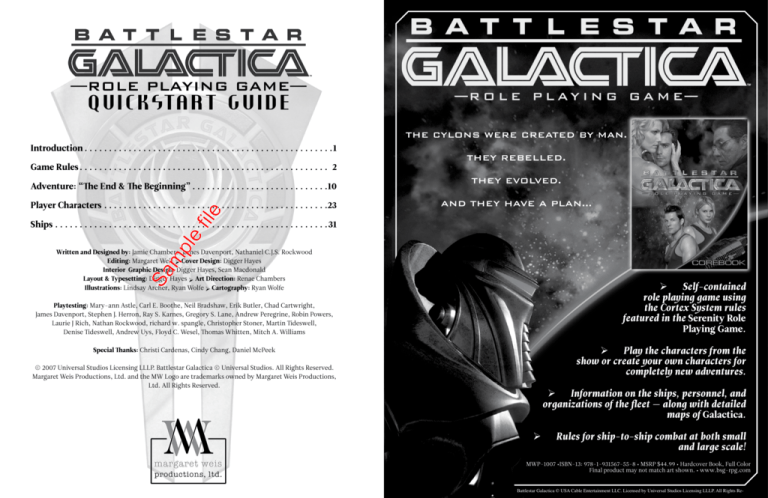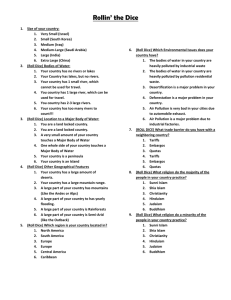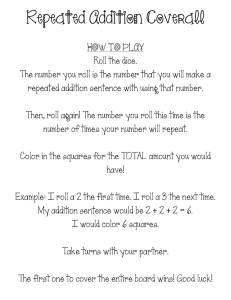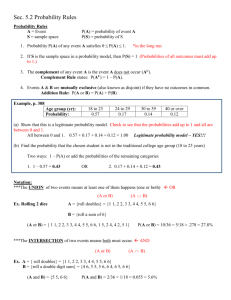
—role playing game—
q u i c k sta r t g u i d e
The Cylons were created by man.
Introduction. . . . . . . . . . . . . . . . . . . . . . . . . . . . . . . . . . . . . . . . . . . . . . . . . . . 1
Game Rules. . . . . . . . . . . . . . . . . . . . . . . . . . . . . . . . . . . . . . . . . . . . . . . . . . . . 2
Adventure: “The End & The Beginning”. . . . . . . . . . . . . . . . . . . . . . . . . . . . 10
They EVOLVED.
And they have a plan...
file
Player Characters. . . . . . . . . . . . . . . . . . . . . . . . . . . . . . . . . . . . . . . . . . . . . . 23
They REBELLED.
ple
Ships. . . . . . . . . . . . . . . . . . . . . . . . . . . . . . . . . . . . . . . . . . . . . . . . . . . . . . . . 31
Sa
m
Written and Designed by: Jamie Chambers, James Davenport, Nathaniel C.J.S. Rockwood
Editing: Margaret Weis ÿ Cover Design: Digger Hayes
Interior Graphic Design: Digger Hayes, Sean Macdonald
Layout & Typesetting: Digger Hayes ÿ Art Direction: Renae Chambers
Illustrations: Lindsay Archer, Ryan Wolfe ÿ Cartography: Ryan Wolfe
ÿ Self-contained
role playing game using
the Cortex System rules
featured in the Serenity Role
Playing Game.
Playtesting: Mary-ann Astle, Carl E. Boothe, Neil Bradshaw, Erik Butler, Chad Cartwright,
James Davenport, Stephen J. Herron, Ray S. Karnes, Gregory S. Lane, Andrew Peregrine, Robin Powers,
Laurie J Rich, Nathan Rockwood, richard w. spangle, Christopher Stoner, Martin Tideswell,
Denise Tideswell, Andrew Uys, Floyd C. Wesel, Thomas Whitten, Mitch A. Williams
ÿ Play the characters from the
show or create your own characters for
completely new adventures.
Special Thanks: Christi Cardenas, Cindy Chang, Daniel McPeek
© 2007 Universal Studios Licensing LLLP. Battlestar Galactica © Universal Studios. All Rights Reserved.
Margaret Weis Productions, Ltd. and the MW Logo are trademarks owned by Margaret Weis Productions,
Ltd. All Rights Reserved.
ÿ Information on the ships, personnel, and
organizations of the fleet — along with detailed
maps of Galactica.
ÿ
Rules for ship-to-ship combat at both small
and large scale!
MWP-1007 •ISBN-13: 978-1-931567-55-8 • MSRP $44.99 • Hardcover Book, Full Color
Final product may not match art shown. • www.bsg-rpg.com
Battlestar Galactica © USA Cable Entertainment LLC. Licensed by Universal Studios Licensing LLLP. All Rights Re-
Introduction
ple
m
Sa
You can use the Battlestar
Galactica (BSG) Role Playing Game
(RPG) to bring to life your own
stories set in the fascinating and
dangerous universe of the Battlestar
Galactica television series. The
possibilities for adventure are
endless. You could reinvent the
series from the start to finish—using
the heroes of the series or replacing
the main characters with characters
of your own creation. Or you could
play out an entirely different type of
story. Perhaps you can tell the tale of
brave colonists who refused to leave
Cylon-occupied Caprica. Or the
story of a group of miners working
on a little-known asteroid when
the attack occurred. Or perhaps you
reveal the struggles of a lone ship
lost in space searching for the fleet.
The Quickstart Guide presents a
short scenario designed to introduce
you to the game, one that starts a
completely new storyline for four
original characters. However,
before you play the adventure or
create one of your own, read the
A BSG game follows the adventures of a group
of people we call the Player Characters (PCs).
These characters might be admirable or despicable,
everyday working class people or elite Viper pilots.
No matter what their backgrounds or personalities
are like, they are the “heroes” of the story.
These characters are created
and controlled by the players,
who describe them, give them
voices, and determine their
actions during the game.
Understanding the basic
rules is important in any role
playing game, but it is even
more important to develop an
understanding of your character.
A player needs to know what
the character looks like, what
drives him, his loves, hatreds,
ambitions, prejudices, and quirks.
While the rules of the game
provide structure and a way to
resolve actions, the creation of a
living, breathing character is the
province of the player.
Learning about the character
will not happen all at once.
Players will discover many
interesting things about the
character during the course of
play. Players will watch their
characters deal with misfortune
and, from these experiences,
learn and grow. The universe of
Battlestar Galactica is harsh and
unforgiving, where even the best
people suffer setbacks and experience
painful loss.
In the BSG universe, human life has
become all but extinct. The Twelve Colonies
have been overrun by Cylons. For the
file
Playing the
Battlestar
Galactica
RPG
Players and
Characters
Game Rules
Welcome to the Quickstart Guide for the Battlestar
Galactica Role Playing Game. In this booklet you
will find simplified rules, pregenerated characters,
and a short adventure set in the Battlestar Galactica
universe—everything you need to run a game! In
addition you will find ideas for creating your own
stories using the provided characters. But this
Quickstart Guide is just an introduction to the exciting
world of Battlestar Galactica. The Battlestar Galactica
Role Playing Game sourcebook provides complete
rules, in-depth profiles of the characters, information
on ships, weapons, technology, politics, ideas for
storylines, as well as character and ship creation rules.
If the sourcebook is not already available in your local
bookstore or hobby store, it soon
will be. Ask for it!
sections dealing with the basic game rules
and style of play. The Quickstart Guide version of
the rules is intended to be simple and streamlined.
They are not nearly as detailed as the rules in the
main sourcebook. So use your imagination and feel
free to wing it. The most important goal is for you
and your players to have fun!
most important rule of all: The story comes first.
When in doubt, give players the edge.
The rules in the following sections are simple and
extremely flexible. You should be able to remember
the basic game mechanics without consulting the
rules. Only the Game Master needs to be well-versed
in the mechanics of game play. While players should
understand the basics, they should focus on playing
their characters, rather than be over-concerned with
dice and numbers.
The Game Master
What You Need
Every game requires a Game Master (GM) who
narrates the basics of the story, presents each
situation, and takes on the role of all the nonplayer characters (NPCs) the PCs meet during their
adventure. The GM creates the story, presents the
challenges, reacts to player decisions, and interprets
the rules, all the while keeping the game fun and the
story moving.
A GM should have material for the game prepared
in advance. The adventure might be one such as
you will find in this book. It may consist of pages of
meticulous notes or it might be a few ideas jotted
down on a scrap of paper. Be aware, however, that
no matter how much advance planning the GM puts
into the adventure, the players will most likely take
the story in unexpected directions—which is why a
good GM is always ready to improvise and roll with
the punches. His job is to set the stage and make sure
everyone is having a good time.
The role of GM places a lot of power (in terms of
the story telling and game play) in the hands of one
person, so the role of a GM should be taken seriously.
A GM should make decisions based on the rules as
fairly as possible and should always remember that he
is telling a story. The players are the main characters.
If this were a television show, the GM would be the
director and the players his all-star cast.
To play out the scenario included in the
Quickstart, you will need:
• Pencils and copies of the Character Sheets found
in the back.
• Polyhedral dice of different kinds: two-sided
(d2), four-sided (d4), six-sided (d6), eight-sided
(d8), ten-sided (d10), and twelve-sided (d12). These
“funny dice” are available at most hobby shops and
game stores. If need be, coins can be used for d2s, you
can modify blank dice, or you can visit
www.bsg-rpg.com to order dice.
• A group of friends to play the game. The
Quickstart Guide assumes four players and one GM.
(The full Battlestar Galactica Role Playing Game will
allow any number of players.)
• A good place to relax and play comfortably,
preferably with few distractions.
Sa
m
ple
file
Quickstart
human survivors, life is fraught with peril.
The setting is grim, the situation tense, and
life for the characters is harsh—all the makings of
an interesting, exciting, nail-biting, edge-of-theseat role playing game! In BSG, characters are put to
the test and pushed to their limits. True character
is revealed when comfort and safety are stripped
away. Those who rise up out of defeat and continue
to struggle on are the true heroes. Danger is everpresent, but its constant companion is hope.
The Rules and
the Story
Even the most comprehensive game system in
the world cannot cover every conceivable situation—
especially in the unpredictable universe of Battlestar
Galactica! The Cortex System rules we use for the
BSG RPG are meant to assist good-storytelling, not
replace it. If a situation comes up that is not explicitly
covered in the rules, the GM should figure out a way
to deal with it and move on. Always remember the
Game Rules
In the following sections are the basic rules of play
for the Battlestar Galactica Role Playing Game. Note that
the Quickstart Guide rules are made simpler than the
full game, to make learning the basics easier for new
players. First we will provide the rules for characters,
including the Attributes, Skills, and Traits that
describe the characters in game terms and allow the
characters to interact with the game world.
Characters
All characters in the game, whether PCs or
NPCs under the control of the GM, are made up of
three components: Attributes, Skills, and Traits.
Attributes determine a character’s raw capabilities
(how strong, smart, and agile he might be). Skills
represent knowledge and experience (can he fly
a Viper or remember passages from the Sacred
Scrolls). Traits represent almost everything else,
including personality, reputation, social status, and
sense of balance. A character with high Agility
has an edge with Skills that involve movement,
aiming, and fast reaction times.
Strength is a character’s physical prowess.
A character with high strength can deal more
damage in hand-to-hand combat, can lift and
carry heavy loads, and can have an edge in certain
athletic contests.
Vitality measures a character’s health and
endurance. High Vitality characters can resist
disease and toxins, can endure longer without
food or rest, and can take more punishment than
others.
Alertness covers awareness—both the
sharpness of a character’s senses and how well
he picks up on what others are telling him. A
character with high Alertness is more likely to see
through a ruse that others would fall for.
Intelligence represents brain-power, the ability
to think and understand. A high Intelligence
allows a character to solve complicated problems
or arrive at conclusions far more quickly than his
friends.
Willpower is determination, drive, and strength
of personality. Those with high Willpower are
often able to persuade others, resist interrogation
and intimidation, and overcome fear.
Sa
m
ple
special talents. Characters may also have “Derived
Attributes” such as Initiative (how fast a character
reacts) and Life Points (how much damage he can
endure before dying). These are explained in the
combat section.
The Quickstart Guide offers four characters that
serve as examples of the type of characters players
could create using the full rules. The Battlestar
Galactica Role Playing Game sourcebook presents
complete character creation rules, allowing players to
invent just about any characters they can imagine.
file
Dice in the Battlestar Galactica RPG form a kind of “ladder” of ability. Each die type, from
two-sided (d2) up through twelve-sided (d12), represents a “step” on this ladder. Higher
Steps, in general, represent greater ability, skill, damage, etc. A d6 is better than a d4,
and a d8 is better than a d6. This ladder can even extend above d12—at that point, a
second die is added, making the next Step “d12 + d2.” That makes the first eight Steps:
d2 • d4 • d6 • d8 • d10 • d12 • d12+d2 • d12+d4. There is, theoretically, no upper limit,
though it would be rare for anything or anyone to begin with a rating higher than d12.
Changes to rolls that make tasks harder or easier are called “step modifiers,” “step
bonuses,” or “step penalties.” These modifiers move the die type up the ladder if positive
or down the ladder if negative. For example, a –1 step penalty would turn a d6 into a
d4, a +2 step modifier would turn a d6 into a d10, and so on. While dice can be reduced
below d2, at that point they become negated entirely (d0), and any further penalty is
ignored.
Game Rules
Steps
Attributes
Characters in BSG have six Attributes: Agility,
Strength, Vitality, Alertness, Intelligence, and
Willpower. These six define a character’s most basic
capabilities. If a character is smart, he probably has
a high Intelligence Attribute. One who is clumsy has
low Agility. All Attributes are rated by the type of dice
the player rolls when using the Attribute. In this game
system, high numbers are always better than low.
While any die types are possible within the game,
an Attribute of d2 would be a crippling deficiency,
while anything above d12 would beyond normal
human expectations. A score of d6 represents the
average for normal human adults.
Agility represents the character’s physical
quickness, dexterity, hand-eye coordination, and
Attributes measure a character’s raw
capabilities. Skills represent what a character
knows. Whether acquired through formal
training, schooling, reading books, or hard-earned
experience, Skills define the types of actions at which
a character excels. Petty Officer Dualla is highly
trained in communications, codes, and ciphers.
Captain Lee Adama is an expert pilot and forceful
leader. Dr. Baltar has a wide-range of technical and
scientific expertise.
Like Attributes, Skills are rated by die types. A
character with a d2 has only basic familiarity with
the Skill. A d6 represents moderate competence, and
a d10 represents an expert. Anything beyond d12 is
exceptionally rare, making the person a genius in
that field.
Certain Skills can be used even without any
training. In game terms this means having no
rating in the Skill whatsoever. A character doesn’t
need a cooking Skill to boil water, for example.
But some actions can (and should) be attempted
only by characters with that Skill. Flying a Colonial
Viper or performing delicate surgery should not be
undertaken without training!
Skills in the BSG Quickstart Guide represent broad
areas of knowledge. Because there are too many Skills
to list here, each Character Sheet includes the list and
descriptions of that character’s Skills.
To use as an example, three Skills a character
might possess are Athletics, Guns, and Influence.
Athletics are used for actions such as swimming,
running, dodging, or playing a game of Pyramid.
Guns cover hand-held weapons, including pistols,
rifles, carbines, and submachine guns. The Skill is
used when shooting, performing basic maintenance,
and in identifying these types of weapons.
Influence covers a character’s ability to
persuade others, whether it is fast-talking, subtle
manipulation, or seduction. This Skill can also be
used for intimidation, leadership, and politics.
Galactica Role Playing Game, these qualities are called
Traits.
Traits are broken down into two categories: Assets,
which are generally positive, and Complications,
which are generally negative. Traits are also rated
as either Major or Minor, which define how strong
an advantage (or disadvantage) the Trait is in game
terms. All characters have at least one trait, but most
have several.
Traits can have a variety of different effects. Some
will provide bonuses or penalties to different types
of rolls; some might involve new ways to spend Plot
Points (see “Story Elements,” page 8); some might
allow occasional re-rolls for failed results. When
creating a character with the complete rules, players
will have access to a broad selection of Traits from
which to choose. For the purposes of the Quickstart
Guide, examples of the available Traits are included in
the descriptions on the pre-made Character Sheets.
Rolling the Dice
When a player wants his character to shoot a
Cylon, rewire a Viper’s engine, or jump the gap
between rooftops while running from a patrol on
occupied Caprica, the character is performing an
action that might either succeed or fail, and this
action will have dramatic consequences no matter
what happens. In the BSG RPG, such actions are
resolved by rolling dice. Exactly what dice are rolled
is determined by the character’s Attributes and Skills,
and the results are interpreted by the Game Master.
Almost all actions consist of one Attribute paired
with one Skill. For example, firing a gun requires
the Agility Attribute paired with the Guns Skill. For
example, a gun in the hands of someone with a low
Agility score means he could drop it or fire wildly. If
a character wishes to try an action and does not have
the skill, he must roll the attribute die only.
Sa
m
ple
file
Quickstart
Skills
Traits
Characters are much more than a collection
of numbers. While Starbuck is a skilled pilot, her
recklessness and devotion to Commander Adama are
what make her truly interesting. President Roslin is
an intelligent leader; her illness and religious beliefs
provide depth and interest. In the Battlestar
D i f f i c u lt y N u m b e r s
Category
Easy
Average
Hard
Formidable
Heroic
Incredible
Ridiculous
Impossible
Simple Actions
Complex Actions
3
7
11
15
19
23
27
31
15
35
55
75
95
115
135
155
Simple Actions
Sa
m
ple
file
Game Rules
Most actions are simple actions—an action that
is resolved in a short period of time.
The GM decides which Attribute and Skill
combination is most appropriate for that particular
action. The player rolls the dice and adds the result
together. If the total is equal to or higher than the
Difficulty Number set by the GM, the character
succeeds. The Difficulty number is either a static
number based on the situation (see the chart below)
or by an opposed roll with another character.
Note actions that involve no risk of failure or no
dramatic consequence do not require any rolls. A
character does not need dice to walk across a room,
take a sip of ambrosia, or flip a light switch. Walking
across the room during a Cylon bombardment with
the floor shaking might require a roll, as would
detecting the odor of poison in your drink or rewiring the light switch. Common sense will generally
tell players and the GM whether a roll is needed.
The pairing of a particular Attribute and Skill is
always determined by the GM based on the situation.
While some combinations come up quite often
(Alertness and Perception, Agility and Guns), they
are never absolute.
For example, Starbuck is running as fast as she can
to reach her Viper during a Cylon assault. When the
alarms first sound, she is running down an empty,
clear corridor on Galactica. She has no obstacles to
dodge, so the GM assigns the action the Strength
Attribute + Athletics Skill. When Starbuck reaches
the hangar deck, she sees live electrical wires have
fallen over the stairs, so she must be extremely
careful to avoid them as she continues. The GM
decides that Alertness + Athletics is the appropriate
roll. When she reaches the deck, Starbuck must avoid
deckhands and equipment to reach her Viper. The GM
decides that this action requires Agility + Athletics.
Complex Actions
While simple actions are resolved quickly, some
will take more time. These Complex Actions can be
as much about how long the action takes rather than
whether or not the PC succeeds. For example, the
PCs will almost certainly be able to repair Galactica’s
FTL drive—but can they do it before the Cylon
basestar is in heavy weapons’ range? Doctor Cottle
will eventually be able to remove a bullet lodged in a
Combat
Most actions within the BSG RPG can be
resolved using the rules above. Combat is a bit more
complicated. Whether the PCs are shooting at a
couple of toasters or they’re involved in a brawl on
the flight deck, the GM turns to the combat rules to
handle the situation.
Combat Turn—
Initiative, Movement,
& Action
Combat is broken down into turns, each roughly
three seconds long. During a turn, all the PCs involved
can take actions that will have their own resolutions.
At that point, the next turn begins and this continues
until combat is over (usually when one side is
defeated).
Initiative: PCs and NPCs act in order of Initiative,
with higher numbers acting first. Check the Initiative
rating for each character (PC or NPC) involved. Each
action is resolved before moving to the PC or NPC
with the next highest Initiative. If any characters
have tied Initiative scores, they may roll Agility dice
to determine who will go first for the duration of
the current combat. The pre-made characters in the
Quickstart Guide have their Initiative scores listed on
their Character Sheets.
Movement: Under normal circumstances a
character may both move and take one combat action
(attack, dodge, etc.) in whatever order the player
chooses. Normal movement allows up to 20 feet at a
fast walk, but a PC may go up to 40 feet per turn by
running—though doing so means the PC cannot take a
combat action for the turn.
Action: Combat actions can be almost anything
that can be accomplished in just a few seconds. A
character might shoot a gun or throw a punch, dodge
his opponent or kick down a door. Note that most
complex actions do not work within the framework of
combat, unless it’s an action in which one turn equals
one roll—which is quite unusual.
As you read the Combat rules, they may seem
at first confusing or very complicated. In truth,
running combat is designed to play fast and easy.
So take heart! We will walk you through the combat
sequences in the adventure found in this booklet. Just
be generally familiar with how the rules work.
Sa
m
ple
file
Quickstart
marine’s liver, but might not be able to do so
before the man bleeds to death.
Complex actions use a difficulty scale much like
simple actions, though the necessary totals are much
higher (see the Difficulty chart, page 4) and they
almost always require more than one roll. A player
attempting a complex action must roll the Attribute
and Skill during the time allotted, keeping a running
total of the results. Each roll represents a set amount
of time determined by the GM (five minutes, an
hour, perhaps even a full day). Once the threshold of
success is reached, the action is completed, and the
player knows how much time has elapsed. If any of
the rolls are a botch (see below) then the action halts
and must be started over if the GM permits.
For example, Chief Tyrol must repair a Viper
engine that was damaged during a combat landing.
The GM decides that he should roll Intelligence +
Mechanical Engineering, and that this is a complex
action with a Difficulty of Hard (55). The GM also
decides that each roll takes half an hour of game
time, and that since the Viper needs to go back out
on patrol in 2 hours, the character has only 4 rolls in
which to reach the total needed to achieve success.
The player makes his first roll and his dice total 10.
The second roll adds up to 15, for a total of 25. The
third roll gives a score of 13, bringing the total to 38.
The Chief had better achieve at least 17 on his fourth
and final roll or he’ll have to deal with an angry CAG!
Botching
Whenever a player rolls any dice for an action
and they all come up as 1, this is called a botch. A
botch means something went terribly wrong. A
botch might cause a gun to jam or a character to lose
his footing. For a simple action, a botch means an
automatic failure, plus the character loses his action
for the next turn. For a complex action, botching
cancels out all rolls and means the character must
start over—and if the circumstances are especially
bad the GM may decide that the action cannot be reattempted.
The GM should feel free to let his imagination soar
when it comes to describing the results of a botched
roll.
Life Points
and
Damage
Defending
file
and
When someone is punching or shooting at you,
the best response is usually to get the hell out of
there. In hand-to-hand fighting, you can block or
dodge; while in ranged combat, finding cover will
hopefully keep you alive.
If a PC is aware of an attack and has not yet used
his action for the turn, he can spend the action
for an active form defense. This provides a Skilled
action to create the Difficulty for the attack—either
a block or a dodge. If the attacker is using Melee
Weapons or Unarmed Combat, the defender may
use his own equivalent Skill to block the attack,
paired with either Agility or Strength (at the GM’s
determination). Dodging can be used against any
kind of attack, with the defender rolling Agility +
Athletics. Note that the PC who uses his turn for
defense loses his combat action for this turn.
If the defending PC is surprised, restrained,
unconscious—or for whatever reason unmoving—the
Difficulty of the attack is automatically set to 3. This
is why snipers have a significant advantage.
If the defender is engaged in combat, able to move
freely, and not using an action to defend himself, he
rolls his Agility attribute alone to create the Difficulty
for the attack. This is called Innate Defense. It is
possible for this to create a Difficulty lower than 3, as
a moving defender can sometimes blunder into the
direction of an attack.
ple
Attacking
Defense
Game Rules
Characters in the BSG RPG often get hurt, and how
much punishment they can take before succumbing
to their wounds is a function of Life Points. A PC with
full Life Points is perfectly healthy. A PC missing
several points is injured or sick. If a PC is reduced to
0 Life Points, he must receive emergency medical
intervention or he will die. Life Points can be restored
through rest at a rate of two days per one Life Point.
Special medical treatments might speed recovery
time.
Damage is most often inflicted during combat,
but it can happen in any number of ways. Characters
might be exposed to toxins, extreme temperatures,
fire, electricity, or radiation. Players should watch
their characters’ Life Point totals. In the BSG universe
danger can come at any moment and life can be
brutally short.
The pre-made PCs have their Life Point totals
listed on their Character Sheets.
An attack uses a character’s action for the
turn. If someone is attacked before their turn,
he may either give up his action in order to defend
(see Defense, below), or make no skilled defense to
keep his attack action. It’s important to remember
the game system is somewhat abstract. While an
attacker may make only one roll in a combat turn, the
PC might be dodging and feinting and fighting for his
life. The GM and the players should work together to
keep the drama and tension of combat high by being
as descriptive as possible. Simply announcing the hit
and damage rolls is dull and will take the fun out of
one of the most exciting elements of the game.
Sa
m
Combat is messy business, with most actions
involving a PC either trying to hurt someone (or
something) while avoiding damage himself. Attack
and Defense are two important concepts that will
cover much of what happens during a combat turn.
An attack is a simple action in which the target’s
Defense is the difficulty number. If the attack roll
is equal to or higher than the Defense, the attack is
successful and damage must be determined. Defense
is the ability of the PC to repel, dodge, thwart or
escape an attack.
Attacks
There is nearly an infinite variety of the kinds of
attacks that can be inflicted on the PCs, but in the BSG
RPG there are only a handful of Skills that normally
come into play: Guns (pistols, rifles); Heavy Weapons
(vehicle-mounted weapons, shoulder-fired rockets);
Melee Weapons (knives, clubs); and Unarmed Combat
(brawling, martial arts). The GM assigns an Attribute
and Skill pair for the attack action. Strength is most
often paired with Melee Weapons and Unarmed
Combat, while Agility is usually used for Guns and
Heavy Weapons—though other Attributes might be
used in unusual circumstances.
Calculating Damage
When the attack roll is equal to or greater than the
defense, the attack is a hit and may cause damage.
Base damage is determined by subtracting the
defense roll from the attack roll.









